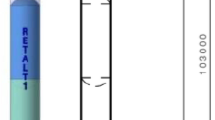Abstract
We studied the process of electrification of a rocket during launch and flight in the atmosphere at the active part of its trajectory. The values of charge, field strength, and rocket potential at the launch are estimated. Charging and discharging currents are determined for a rocket flying through clouds and precipitation, and solutions expressing the time variation of the rocket’s charge are found. The values of charge, field strength, and rocket potential are obtained as functions of time, together with the engine plume represented as a charged plasma structure. The rocket’s charge is shown to tend to an equilibrium state, and the time of reaching it is found. Mechanisms limiting the charge value are considered, and the conditions of origination of an electric breakdown (lightning) between the rocket and atmosphere are determined.
Similar content being viewed by others
References
Imyanitov, I.M., On the Mechanism of Electrostatic Charging, Dokl. Akad. Nauk SSSR, 1958, vol. 121, no. 1, p. 93.
Imyanitov, I.M. and Starovoitov, A.T., Some Issues of the Theory of Electrostatic Charging of Bodies in Flows, Zh. Tekh. Fiz., 1962, vol. 32, no. 6, p. 759.
Imyanitov, I.M., Elektrizatsiya samoletov v oblakakh i osadkakh (Electrification of Airplanes in Clouds and Precipitation), Leningrad: Gidrometeoizdat, 1970.
Buchin, V.A., Vatazhin, A.B., and Pudov, M.V., Electric Charging of Bodies due to Charged Particles Carried out from Them by a Gas-Dynamic Flow, Izv. Akad. Nauk SSSR, Mekh. Zhidk. Gaza, 1977, no. 5, p. 94.
Pinchuk, V.A., Propulsion System Electrification as a Phenomenon Reflecting the Charge Instability in the Medium of Combustion Products during Their Outflow, Zh. Tekh. Fiz., 1997, vol. 67, no. 8, p. 21.
Bazelyan, E.M. and Raizer, Yu.P., Fizika molnii i molniezashchity (Lightning Physics and Lightning Protection), Moscow: Fizmatlit, 2001.
Shuneiko, I.I., Manned Flights to the Moon, Design and Performance of Saturn V Apollo, in Raketostroenie, tom III (Rocket Production, vol. III), Moscow: Gos. Komitet Sov. min. SSSR po nauke i tekhnike, 1973.
Uman, M.A., Natural and Artificially-Initiated Lightning and Lightning Test Standards, Proc. of IEEE, 1988, vol. 76, no. 12, pp. 1548–1565.
Karlov, V.D., Kozlov, S.I., Kudryavtsev, V.P., et al., One Type of Large-Scale Disturbances in the Ionosphere, Geomagn. Aeron., 1984, vol. 24, no. 2, p. 319.
Burdakov, V.P. and Danilov, Yu.I., Vneshnie resursy i kosmonavtika (External Resources and Space Exploration), Moscow: Atomizdat, 1976.
Dumin, Yu.V., Possible Acceleration of Charged Particles by Residual Electric Field of a Rocket, Kosm. Issled., 1993, vol. 31, no. 5, p. 154.
Kolechitskii, E.S., Raschet elektricheskikh polei ustroistv vysokogo napryazheniya (Calculation of Electric Fields for High-Voltage Equipment), Moscow: Energoatomizdat, 1983.
Landau, L.D. and Lifshitz, E.M., Electrodynamics of Continuous Media, Oxford: Pergamon, 1960.
Aronowitz, L., Electrostatic Potential Generated by Rockets on Vehicles in Space, IEEE Trans. on Electromagn. Compatibility, 1968, vol. EMC-10, no. 4, p. 341.
Nagel’, Yu.A., Electrification of Engines due to Outflow of Combustion Products: Experimental Results, Zh. Tekh. Fiz., 1999, vol. 69, no. 8, p. 55.
Pinchuk, V.A., Low-Temperature Plasma under Conditions of External Acoustic Actions, Inzh.-Fiz. Zh., 1994, vol. 67, no. 1, p. 112.
Vatazhin, A.B., Grabovskii, V.I., Likhter, V.A., et al., Elektrogazodinamicheskie techeniya (Electrical Gas-Dynamic Flows), Moscow: Nauka, 1983.
Shkalikov, V.A., Teplovye protsessy i svoistva rabochikh tel dvigatelei letatel’nykh apparatov, (Thermal Processes and Properties of Working Substances of Engines for Flying Vehicles), Alemasov, V.E., Ed., Kazan: KAI, 1980.
Fedorov, V.A., Screening by Engine Plume of the Telemetry Communication Channel ‘Carrier Rocket — Measurement Point’, Radiotekh. Elektron., 2008, vol. 53, no. 8, p. 964.
Osnovy zagorizontnoi radiolokatsii (Principles of Over-the-Horizon Radio Location) Kolosov, A.A., Ed., Moscow: Radio i Svyaz’, 1984.
Tannehill, J.C. and Anderson, E.W., Intermediate Altitude Rocket Exhaust Plumes, J. Spacecr. Rockets, 1971, vol. 8, no. 10, p. 1052.
Teoriya raketnykh dvigatelei (Theory of Rocket Engines) Alemasov, V.E., Ed., Moscow: Mashinostroenie, 1969.
Raizer, Yu.P., Fizika gazovogo razryada (Physics of Gas Discharge), Moscow: Nauka, 1992.
Gurevich, A.V. and Shwartsburg, A.B., Nelineinaya teoriya rasprostraneniya radiovoln v ionosfere (Nonlinear Theory of Radio-Wave Propagation in the Ionosphere), Moscow: Nauka, 1973.
Author information
Authors and Affiliations
Corresponding author
Additional information
Original Russian Text © V.A. Fedorov, 2011, published in Kosmicheskie Issledovaniya, 2011, Vol. 49, No. 4, pp. 384–391.
Rights and permissions
About this article
Cite this article
Fedorov, V.A. Electrification of a rocket during its launch and motion in the atmosphere along active part of the trajectory. Cosmic Res 49, 374–381 (2011). https://doi.org/10.1134/S0010952511040046
Received:
Published:
Issue Date:
DOI: https://doi.org/10.1134/S0010952511040046




